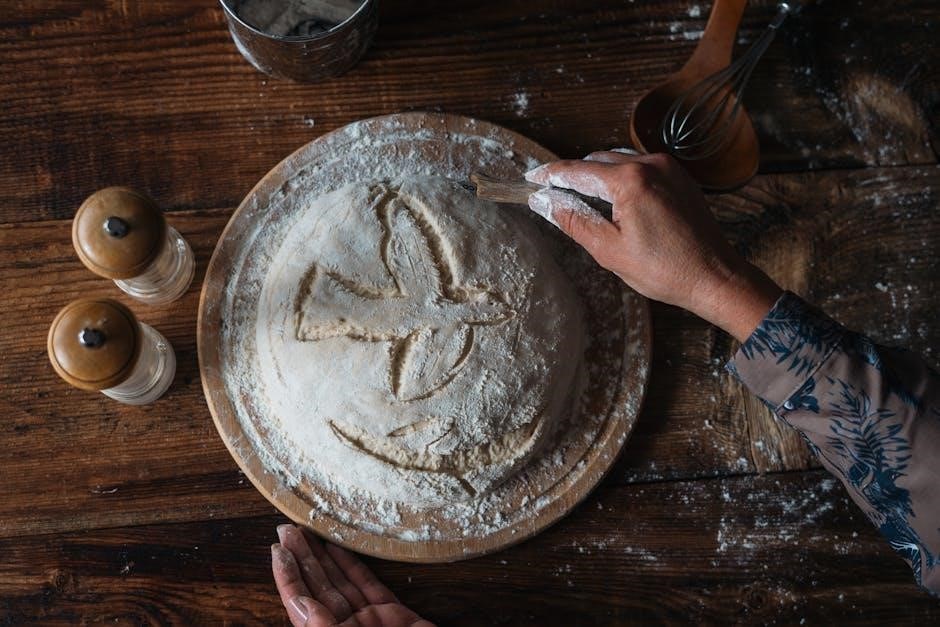Bonnaroo is a world-renowned four-day music festival held annually in Manchester‚ Tennessee‚ on a 700-acre farm․ It’s a celebration of music‚ art‚ and community‚ attracting fans from across the globe․ Preparing properly ensures an unforgettable experience‚ making it essential to pack wisely for comfort and enjoyment․ With its unique setting and diverse activities‚ Bonnaroo offers a holistic festival experience․
What is Bonnaroo?
Bonnaroo is a world-renowned four-day music and arts festival held annually in Manchester‚ Tennessee‚ on a sprawling 700-acre farm․ Known for its diverse lineup of genres‚ from rock and pop to jazz and electronic music‚ the festival attracts thousands of fans each year․ It’s more than just a concert—it’s a cultural experience‚ featuring art installations‚ comedy performances‚ and a vibrant community atmosphere․ Bonnaroo has become a cornerstone of music festivals in the U․S․‚ offering a unique opportunity to connect with fellow music lovers and enjoy unforgettable performances․ The festival’s laid-back‚ inclusive vibe makes it a must-attend event for both first-timers and seasoned festival-goers․ With its rich history and dedication to creating an immersive experience‚ Bonnaroo continues to be a celebration of music‚ art‚ and self-expression․
Why Proper Packing is Essential
Proper packing is crucial for a seamless and enjoyable Bonnaroo experience․ The festival’s four-day duration‚ combined with its outdoor setting‚ means attendees must be prepared for varying conditions․ Essentials like sunscreen‚ hydration packs‚ and comfortable clothing are vital to withstand the heat and extensive walking․ Additionally‚ the festival’s remote location can make last-minute purchases inconvenient and costly․ A well-organized packing list ensures you don’t forget critical items like ear protection‚ toiletries‚ or a reusable water bottle․ Overlooking these can lead to discomfort or unnecessary expenses․ Proper packing also allows you to focus on the music‚ art‚ and community‚ making the experience more enjoyable․ By planning ahead‚ you can avoid stress and make the most of your time at the festival․ A thoughtfully packed bag is key to maximizing your Bonnaroo adventure and creating lasting memories․

Festival Essentials
Packing festival essentials like sunscreen‚ reusable water bottles‚ and earplugs ensures comfort and safety․ Proper footwear‚ lightweight clothing‚ and a hydration pack are must-haves for navigating the festival grounds efficiently․
Festival Admission and Tickets
Festival admission and tickets are the first steps to ensuring a smooth Bonnaroo experience․ A valid wristband is required for entry and must be registered online before the festival․ Wristbands are non-transferable‚ so make sure to purchase them directly from authorized sellers․ Bring a valid ID‚ as it may be requested during entry․ Tickets can be purchased as general admission‚ VIP‚ or single-day passes‚ depending on your preferences․ Check the festival website for ticket options and pricing․ Upon arrival‚ be prepared for security checks and bag inspections․ Carry your ticket confirmation‚ ID‚ and cash for incidentals․ Familiarize yourself with prohibited items to avoid delays at the gate․ Plan ahead to avoid last-minute ticket purchases from unreliable third-party sellers․ Proper admission preparation ensures a hassle-free start to your Bonnaroo adventure;
Camping Gear Basics
Camping gear is essential for a comfortable Bonnaroo experience․ Start with a sturdy tent designed for multi-day use‚ ensuring it can withstand varying weather conditions․ A sleeping bag or pad is crucial for a good night’s rest‚ while a tarp offers extra protection from rain․ Don’t forget camping chairs‚ tables‚ and a shade structure like a canopy for daytime relaxation․ Lighting is key‚ so pack a reliable flashlight‚ headlamp‚ or lantern‚ along with extra batteries․ A reusable water bottle or hydration pack is vital for staying hydrated․ Camping stakes‚ ropes‚ and a mallet will help secure your tent․ Consider bringing a portable camping stove or cooking gear if you plan to prepare meals․ Remember to check Bonnaroo’s prohibited items list to avoid bringing restricted gear․ Organizing your camping essentials ensures you’re ready for any situation‚ making your festival stay enjoyable and stress-free․

Clothing and Footwear
Clothing and footwear are crucial for comfort and practicality at Bonnaroo․ Opt for breathable‚ lightweight fabrics like cotton or moisture-wicking materials to stay cool in the heat․ Pack extra shirts and shorts‚ as you’ll likely sweat throughout the day․ Include a mix of tank tops‚ t-shirts‚ and long-sleeved shirts for varying temperatures․ Comfortable footwear is a must‚ as you’ll walk miles daily․ Sturdy sneakers or hiking sandals are ideal for navigating the festival grounds․ Bring socks in abundance to prevent blisters and keep your feet dry․ Consider layers for cooler evenings‚ such as sweatshirts or light jackets․ Don’t forget a hat‚ sunglasses‚ and a bandana for sun protection․ Avoid loose clothing that could get caught in stage barriers․ A rain jacket or poncho is also a smart addition‚ as unexpected showers are common․ Dressing practically and comfortably ensures you can focus on enjoying the music and atmosphere․ Pack extra clothes to change into if needed‚ and don’t forget undergarments and sleepwear for downtime․
Toiletries and Hygiene Products
Toiletries and hygiene products are essential for maintaining personal cleanliness and comfort during Bonnaroo․ Pack a travel-sized toiletry bag with toothbrush‚ toothpaste‚ deodorant‚ and biodegradable soap․ Include wet wipes for quick cleanups when showers are unavailable․ A small first-aid kit with band-aids and antiseptic wipes is also a must․ Bring hand sanitizer and baby wipes for maintaining hygiene on the go․ Feminine hygiene products should be packed in sufficient quantity‚ along with a small supply of toilet paper‚ as festival facilities can be limited․ Moist towelettes and dry shampoo can help manage hair and body hygiene without water․ Don’t forget any personal medications or supplements․ Reusable containers for toiletries are eco-friendly and space-saving․ Proper hygiene practices ensure a fresh and enjoyable festival experience‚ even in the outdoor setting․ Be mindful of the environment by choosing biodegradable and sustainable products whenever possible․ Remember to keep these items easily accessible in your campsite or backpack for convenience throughout the day․

Concert and Venue Preparation
Earplugs protect hearing from loud music‚ while flashlights or headlamps illuminate paths at night․ Reusable water bottles keep you hydrated‚ ensuring comfort throughout the festival experience and performances․
Ear Protection and Hearing Safety
Protecting your hearing at Bonnaroo is crucial due to the loud music levels․ Invest in high-quality earplugs designed for concerts‚ which reduce decibel levels without muffling sound quality․ These are especially important for fans standing near speakers or attending multiple performances․ Reusable earplugs are both eco-friendly and cost-effective‚ making them a festival essential․ Additionally‚ consider bringing backups in case the first pair is lost or damaged․ Hearing safety ensures you can enjoy the music without long-term consequences‚ allowing you to fully immerse in the festival experience․ Don’t underestimate the importance of ear protection—it’s a small investment for lasting hearing health and uninterrupted enjoyment of your favorite artists․
Lighting and Navigation Tools
Lighting and navigation tools are essential for navigating Bonnaroo’s vast festival grounds‚ especially at night․ A reliable flashlight‚ lantern‚ or headlamp is a must-have to illuminate your path and set up camp․ Don’t forget extra batteries‚ as you’ll be using these items frequently․ LED flashlights are highly recommended for their brightness and energy efficiency․ Additionally‚ consider bringing glow sticks for quick‚ easy lighting when moving between stages or campsites․ A portable LED candle can also provide soft‚ ambient light without the risk of open flames․ Navigation tools like a festival map or a downloaded GPS app on your phone will help you find stages‚ vendors‚ and your campsite efficiently․ Proper lighting ensures safety and convenience‚ allowing you to enjoy the festival without missing out on any performances or activities․
Reusable Water Bottles and Hydration Packs
Staying hydrated is crucial at Bonnaroo‚ especially with the Tennessee heat and constant activity․ A reusable water bottle or hydration pack is a must-have to ensure you always have water on hand․ Look for a BPA-free‚ durable option that can withstand the festival’s demands․ Hydration packs are ideal for carrying extra water‚ snacks‚ and small essentials while keeping your hands free․ Bring at least one reusable bottle‚ and consider a second as a backup․ Empty bottles can be refilled at water stations throughout the festival grounds․ Avoid single-use plastics to reduce waste and support Bonnaroo’s sustainability efforts․ Staying hydrated will keep your energy levels up‚ allowing you to fully enjoy the music‚ art‚ and experiences the festival offers․ Don’t underestimate the importance of proper hydration—pack accordingly to stay refreshed and ready for anything․

Camping Checklist
A well-organized camping checklist ensures a comfortable and enjoyable Bonnaroo experience․ Includes essentials like a sturdy tent‚ sleeping gear‚ camping chairs‚ and cooking supplies․ Don’t forget lanterns‚ extra batteries‚ and reusable utensils․

Tent and Sleeping Gear
A sturdy‚ waterproof tent is essential for Bonnaroo camping․ Choose a size that fits your group comfortably and ensure it’s easy to assemble․ Bring a sleeping bag rated for varying temperatures‚ as nights can be cool․ Include a sleeping pad or air mattress for added comfort․ Don’t forget extra blankets or a tarp for ground protection․ A reliable tent stake hammer and rope will help secure your setup․ Consider a tent with good ventilation to prevent condensation buildup․Pack a repair kit with duct tape and spare stakes in case of unexpected damage․ Ensure all gear is in good condition to withstand the festival’s outdoor conditions․ Proper tent and sleeping gear will ensure a well-rested and enjoyable experience throughout the festival․

Camping Chairs and Tables
Camping chairs and tables are essential for creating a comfortable and relaxing space at your Bonnaroo campsite․ Opt for lightweight‚ foldable chairs that are easy to carry and durable enough to withstand outdoor conditions․ A compact camping table is ideal for preparing meals or storing essentials like snacks‚ drinks‚ and toiletries․ Look for tables with built-in cup holders to keep your beverages secure․ Consider bringing a small‚ portable canopy or shade structure to protect your seating area from the sun․ Don’t forget a carrying bag for your chairs to make transportation easier․ Ensure your setup is sturdy and secure to handle wind or uneven terrain․ These items will enhance your camping experience‚ providing a cozy spot to unwind between performances and enjoy time with friends․
Cooking and Food Supplies
Cooking and food supplies are crucial for a comfortable Bonnaroo experience․ Bring a portable camping stove or grill to prepare meals․ Don’t forget fuel for your stove‚ as well as a lighter or matches․ Pack reusable cookware‚ like a pot‚ pan‚ and utensils‚ to minimize waste․ Food supplies should include non-perishable items like canned goods‚ bread‚ and trail mix․ Fresh fruits and vegetables can be brought but ensure they won’t spoil quickly․ Consider pre-cooked meals or meal kits for convenience․ Store food in airtight containers to protect against pests and moisture․ Bring plenty of water for drinking‚ cooking‚ and cleaning‚ and use reusable water bottles․ Don’t forget a cooler with ice packs for perishable items․ Remember to pack spices and seasonings to add flavor to your meals․ Properly dispose of waste to maintain a clean and eco-friendly campsite․ These essentials will keep you well-fed and energized throughout the festival․
Camping Snacks and Energy Foods
Camping snacks and energy foods are vital for maintaining energy levels throughout the festival․ Pack non-perishable items like nuts‚ trail mix‚ dried fruit‚ and jerky for quick bites․ Energy bars‚ such as Clif bars or granola bars‚ are perfect for on-the-go fuel․ Bring plenty of candy like Skittles‚ Twizzlers‚ or Cheez-Its for a sweet pick-me-up․ Fresh fruit cups or GORP (Good Old Raisins and Peanuts) are great healthy options․ Snacks like pretzels and crackers are also easy to carry and eat․ Avoid messy or heavy foods that might be difficult to manage while walking or camping․ Reusable containers or ziplock bags can help keep snacks fresh and organized․ Don’t forget to stock up on water and electrolyte-rich drinks to stay hydrated․ These snacks will keep you energized and ready to enjoy all the music and activities Bonnaroo has to offer․ Remember to refill your supplies as needed to ensure you never run out of essentials․

Personal and Safety Items
A first aid kit‚ medications‚ sunscreen‚ bug spray‚ and emergency supplies are essential․ Don’t forget a flashlight‚ earplugs‚ and a small wallet for safekeeping personal belongings during the festival․
First Aid Kit and Medications
A well-stocked first aid kit is crucial for any Bonnaroo attendee․ Include band-aids‚ antiseptic wipes‚ pain relievers‚ and any personal medications․ Don’t forget prescription drugs with proper labels․ Add over-the-counter remedies for common issues like headaches or allergies․ A small supply of antacids and anti-diarrheal medication can also be helpful․ Pack blister care items‚ as extensive walking is common․ Consider including a first-aid manual for guidance․ Keep everything organized and easily accessible in a clear‚ waterproof pouch․ Always check expiration dates and restock as needed․ Having a first aid kit ensures minor injuries and discomforts don’t disrupt your festival experience․ Remember to store it safely to avoid loss or contamination․ A prepared attendee is a happy attendee!
Sunscreen and Sun Protection
Sunscreen and sun protection are non-negotiable for a comfortable Bonnaroo experience․ Opt for a broad-spectrum sunscreen with high SPF and reapply every two hours‚ especially after sweating or swimming․ Pack lip balm with SPF to protect your lips․ A wide-brimmed hat and polarized sunglasses are essential for shielding your face and eyes․ Lightweight‚ breathable clothing with UPF protection can also help block harmful UV rays․ Don’t forget after-sun lotion to soothe skin after a day in the sun․ While clouds may appear‚ the Tennessee sun can be intense‚ so staying protected is crucial․ Proper sun care ensures you can enjoy the music and activities without discomfort․ Remember‚ sunburns can quickly ruin the festival vibe‚ so prioritize sun protection in your packing list․
Bug Spray and Insect Repellent
Bug spray and insect repellent are vital for a comfortable Bonnaroo experience․ The festival grounds can be buggy‚ especially in the evenings and near grassy areas․ Opt for a reliable DEET-based or picaridin spray with at least 20% active ingredients for optimal protection․ For those preferring eco-friendly options‚ natural repellents like lemongrass or citronella are available‚ though they may require more frequent application․ Pack a travel-sized spray to keep in your festival bag for easy access․ Consider bringing wipes for delicate skin or kids․ Insect repellent is a must to avoid mosquito bites and other bugs‚ ensuring you enjoy the music without discomfort․ Don’t let bugs disrupt your fun—stay protected and prepared․ Remember‚ a good repellent is key to a peaceful festival experience․
Emergency Supplies and Flashlights
Emergency supplies and flashlights are crucial for safety and comfort at Bonnaroo․ Pack a reliable flashlight or headlamp with extra batteries to navigate campgrounds and venues after dark․ Include a small first aid kit with band-aids‚ antiseptic wipes‚ pain relievers‚ and any personal medications․ A multi-tool or pocketknife can help with unexpected tasks‚ while a whistle serves as a safety precaution․ Don’t forget an emergency blanket for cooler nights or unexpected situations․ These items ensure you’re prepared for minor mishaps and can handle emergencies effectively․ Flashlights are especially important due to limited lighting in large areas‚ so bring a spare just in case․ Keep your emergency supplies easily accessible in your campsite or festival bag․ Being prepared allows you to focus on enjoying the music and atmosphere without unnecessary stress․

Additional Tips and Tricks
Plan ahead‚ budget wisely‚ and pack comfort items like a portable charger․ Stay organized with a checklist to ensure nothing is forgotten․ Enjoy the festival stress-free with these smart tips!
Comfort and Convenience Items
Ensuring comfort and convenience is key to maximizing your Bonnaroo experience․ Bring a reusable water bottle or hydration pack to stay hydrated throughout the day․ Comfortable shoes are a must‚ as you’ll likely walk miles across the festival grounds․ Don’t forget extra socks and breathable clothing to manage sweat and heat․ A portable charger for your phone or other devices is essential‚ given limited power sources․ Pack snacks like granola bars‚ trail mix‚ or dried fruit to keep your energy up between meals․ A lightweight‚ quick-drying towel and wet wipes can be lifesavers for staying clean․ Earplugs are a smart addition to protect your hearing during loud performances․ Lastly‚ consider a small blanket or foldable chair for relaxation during downtime․ These items will help you stay comfortable and enjoy the festival without hassle․

Budgeting and Financial Preparation
Proper financial planning is crucial for a stress-free Bonnaroo experience․ Set a budget for tickets‚ transportation‚ food‚ and merchandise․ Festival tickets are a major expense‚ so plan accordingly․ Bring cash for vendors‚ as not all accept cards‚ and consider setting a daily spending limit․ Allocate funds for meals‚ averaging $10-$15 per meal‚ and budget extra for souvenirs or unexpected costs․ Pre-purchase parking or shuttle passes to avoid higher on-site prices․ Many attendees use wristbands with cashless payment options for convenience․ Additionally‚ factor in gas or travel costs if driving․ Having a financial plan ensures you can enjoy the festival without overspending․ Budgeting ahead of time allows you to focus on the music‚ art‚ and camaraderie that make Bonnaroo unforgettable․
Weather-Appropriate Clothing
Packing weather-appropriate clothing is essential for a comfortable Bonnaroo experience․ June weather in Manchester‚ Tennessee‚ is typically hot and humid‚ with temperatures often reaching the mid-90s․ Bring lightweight‚ breathable clothing like tank tops‚ t-shirts‚ and sundresses to stay cool․ Include moisture-wicking fabrics to manage sweat during long days of walking and dancing․ A hat and sunglasses are must-haves for sun protection․ Rain is common‚ so pack a lightweight rain jacket or poncho․ Comfortable shoes are a priority‚ as you’ll likely walk miles each day․ Sandals or flip-flops are ideal for warmer moments‚ but sturdy shoes are better for uneven terrain․ Layering is key for cooler evenings‚ so include a sweatshirt or light jacket․ Don’t forget swimwear for any water activities․ Check the forecast before leaving to ensure you’re prepared for any weather conditions․ Proper clothing choices will help you enjoy the festival without discomfort․
Checklist for Last-Minute Items
Before heading out‚ ensure you’ve packed these last-minute essentials for a seamless Bonnaroo experience․ Double-check your festival admission wristband‚ cash‚ and credit cards for incidentals․ Pack a reusable water bottle or hydration pack to stay hydrated․ Don’t forget sunscreen‚ lip balm‚ and bug spray to protect yourself from the elements․ A portable phone charger and power bank are must-haves for keeping devices charged․ Bring a small flashlight or headlamp for navigating at night․ Include a lightweight rain jacket or poncho‚ as rain is common․ A first-aid kit with pain relievers‚ band-aids‚ and antacids is crucial for minor mishaps․ Add a pack of wipes for quick cleanups․ Don’t overlook extra socks‚ underwear‚ and a change of clothes in case of unexpected wet conditions․ Finally‚ review the festival’s prohibited items list to avoid bringing anything restricted․ A last-minute checklist ensures you’re fully prepared for an unforgettable weekend at Bonnaroo․























































